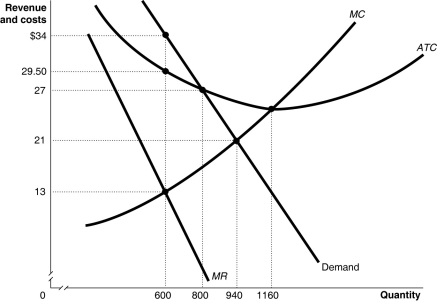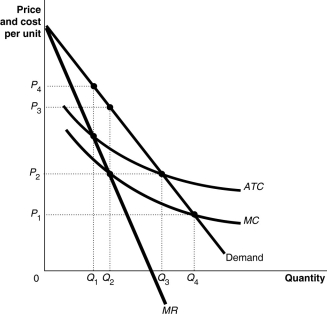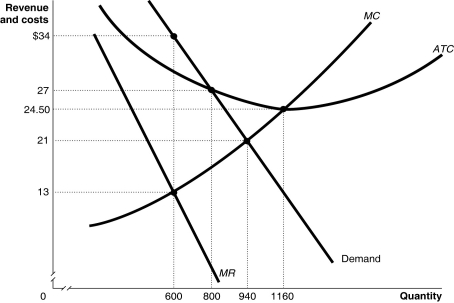Exam 13: Monopoly and Antitrust Policy
Exam 1: Economics: Foundations and Models145 Questions
Exam 2: Trade-Offs, Comparative Advantage, and the Market System151 Questions
Exam 3: Where Prices Come From: the Interaction of Demand and Supply159 Questions
Exam 4: Economic Efficiency, Government Price Setting, and Taxes127 Questions
Exam 5: Externalities, Environmental Policy, and Public Goods141 Questions
Exam 6: Elasticity: the Responsiveness of Demand and Supply149 Questions
Exam 7: Comparative Advantage and the Gains From International Trade125 Questions
Exam 8: Consumer Choice and Behavioral Economics154 Questions
Exam 9: Technology, Production, and Costs169 Questions
Exam 10: Firms in Perfectly Competitive Markets153 Questions
Exam 11: Monopolistic Competition140 Questions
Exam 12: Oligopoly: Firms in Less Competitive Markets130 Questions
Exam 13: Monopoly and Antitrust Policy146 Questions
Exam 14: The Markets for Labour and Other Factors of Production149 Questions
Exam 15: Public Choice, Taxes, and the Distribution of Income134 Questions
Exam 16: Pricing Strategy132 Questions
Exam 17: Firms, the Stock Market, and Corporate Governance137 Questions
Select questions type
Figure 13.3
 Figure 13.3 shows the demand and cost curves for a monopolist.
-Refer to Figure 13.3.What is the price charged for the profit-maximizing output level?
Figure 13.3 shows the demand and cost curves for a monopolist.
-Refer to Figure 13.3.What is the price charged for the profit-maximizing output level?
Free
(Multiple Choice)
4.9/5  (29)
(29)
Correct Answer:
D
A merger between two competitors may be approved by the Competition Bureau if the two companies can substantiate ________ as a result of the merger.
Free
(Multiple Choice)
4.8/5  (35)
(35)
Correct Answer:
D
If a firm's average total cost is less than price where MR=MC,
Free
(Multiple Choice)
4.8/5  (34)
(34)
Correct Answer:
C
Table 13.1
Price per Unit Quantity Demanded (units) Total Cost of Production (dollars) \ 85 10 \ 530 80 11 540 75 12 550 70 13 560 65 14 575 60 15 595 55 16 625
A monopoly producer of foreign language translation software faces a demand and cost structure as given in Table 13.1.
-Refer to Table 13.1.What is the amount of the firm's profit?
(Multiple Choice)
4.8/5  (40)
(40)
In a natural monopoly, throughout the range of market demand
(Multiple Choice)
4.8/5  (31)
(31)
Relative to a perfectly competitive market, a monopoly results in
(Multiple Choice)
4.8/5  (43)
(43)
Figure 13.9
 Figure 13.9 shows the cost and demand curves for the Erickson Power Company.
-Refer to Figure 13.9.If the government regulates Erickson Power Company so that the firm can earn a normal profit, the price would be set at ________ and the output level is ________.
Figure 13.9 shows the cost and demand curves for the Erickson Power Company.
-Refer to Figure 13.9.If the government regulates Erickson Power Company so that the firm can earn a normal profit, the price would be set at ________ and the output level is ________.
(Multiple Choice)
4.8/5  (29)
(29)
A possible advantage of a horizontal merger for the economy is that
(Multiple Choice)
4.8/5  (30)
(30)
What happens to a monopoly's revenue when it sells more units of its product?
(Essay)
4.9/5  (45)
(45)
If an increase in the price of PC Cola causes the profits of President's Choice to decrease
(Multiple Choice)
4.7/5  (40)
(40)
If a monopolist's price is $50 per unit and its marginal cost is $25, then
(Multiple Choice)
4.9/5  (22)
(22)
Figure 13.5
 Figure 13.5 shows the demand and cost curves for a monopolist.
-Refer to Figure 13.5.What is the economically efficient output level?
Figure 13.5 shows the demand and cost curves for a monopolist.
-Refer to Figure 13.5.What is the economically efficient output level?
(Multiple Choice)
4.9/5  (32)
(32)
Figure 13.5
 Figure 13.5 shows the demand and cost curves for a monopolist.
-Refer to Figure 13.5.What is the difference between the monopoly's price and perfectly competitive industry's price?
Figure 13.5 shows the demand and cost curves for a monopolist.
-Refer to Figure 13.5.What is the difference between the monopoly's price and perfectly competitive industry's price?
(Multiple Choice)
4.9/5  (41)
(41)
The Ecke's family virtual monopoly on commercial poinsettia production by grafting together two varieties of the plant ended around 1996 when university researchers were able to independently make the same discovery.The Ecke family did not patent their grafting process.Would the Ecke's have been better off if they had patented their process of growing poinsettias?
(Multiple Choice)
4.9/5  (38)
(38)
An example of a monopoly based on control of a key resource is
(Multiple Choice)
4.8/5  (37)
(37)
Table 13.2
Price per Dose Quantity Demanded (dose) Total Cost of Production (dollars) \ 80 0 \ 80 72 1 82 64 2 88 56 3 100 48 4 124 40 5 164 32 6 208 24 7 268 16 8 340
Onawy Inc. has been granted a patent for its birch root toothache balm. Table 13.2 shows the demand and the total cost schedule for the firm.
-Refer to Table 13.2.What is the amount of Onawy's profit?
(Multiple Choice)
4.9/5  (37)
(37)
The International Nickel Company of Canada had a monopoly until the end of World War II because
(Multiple Choice)
4.8/5  (32)
(32)
Most pharmaceutical firms selling prescription drugs continue to earn economic profits long after the patents on the prescription drugs expire because they have established a strong foothold in the market.
(True/False)
4.9/5  (33)
(33)
Showing 1 - 20 of 146
Filters
- Essay(0)
- Multiple Choice(0)
- Short Answer(0)
- True False(0)
- Matching(0)